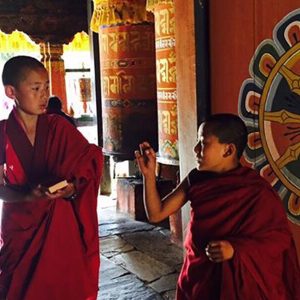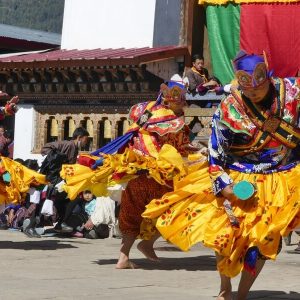Introduction: Bhutan, a Sanctuary of Unique Life
Tucked away in the eastern Himalayas, Bhutan is often called the “Last Shangri-La” for its pristine landscapes, deep-rooted culture, and commitment to preserving both nature and heritage. Beyond its dramatic mountains, ancient monasteries, and colorful festivals, the kingdom is home to an astonishing array of plants and animals found nowhere else on Earth.
From subtropical jungles to alpine meadows, Bhutan’s varied ecosystems create ideal habitats for species that have evolved in isolation over millennia. Many of these creatures and plants are endemic, meaning they exist only within the borders of our Himalayan kingdom, making Bhutan a global hotspot for biodiversity.
Exploring Bhutan is not just a journey through stunning scenery—it is an immersion into a living museum of evolutionary wonders. From elusive snow leopards prowling the northern peaks to delicate rhododendrons and orchids blooming in hidden valleys, Bhutan offers a glimpse into nature in its purest form.
In this article, we will take a closer look at Bhutan’s endemic and rare flora and fauna, uncovering the remarkable species that define this Himalayan paradise and the conservation efforts that ensure they continue to thrive.
Endemic Flora of Bhutan
Bhutan’s Botanical Treasures Bhutan’s diverse ecosystems, ranging from subtropical forests to alpine meadows, host a remarkable array of endemic plant species.
These plants are not only botanically significant but also integral to Bhutan’s cultural and ecological landscape.
Notable Endemic Plant Species
Artemisia bhutanica

A species of mugwort endemic to the Bhutan Himalayas, thriving in open disturbed areas between 2,750 and 3,850 meters. It’s characterized by its glandular and reddish-hairy stems, with small bisexual flowers that bloom in summer. Locals sometimes use it in traditional herbal remedies, highlighting its ecological and cultural importance.
Rhododendron kesangiae

Found in fir and hemlock forests at altitudes of 2,600 to 3,200 meters, this species blooms from April to May, displaying rose-pink flowers that gradually fade to purple. Its striking floral display attracts pollinators such as bees and birds, supporting forest biodiversity. The plant also holds a special place in local cultural traditions, often featured in festivals and ceremonial decorations.
Cephaloziella longii
An endemic liverwort species contributing to Bhutan’s unique nonvascular plant diversity. It thrives in moist, shaded forest floors and plays a crucial role in soil stabilization and nutrient cycling. Though small and easily overlooked, it forms an essential part of Bhutan’s rich botanical heritage.
Lewinskya tortifolia

A moss species endemic to Bhutan, adding to the diversity of bryophytes in the region. It is often found on rocks and tree trunks in temperate forests, helping retain moisture and provide microhabitats for invertebrates. Its presence indicates healthy forest ecosystems, making it a valuable species for conservation studies.
Conservation Efforts
Bhutan’s commitment to preserving its unique flora is evident in its extensive network of protected areas. The National Biodiversity Centre plays a pivotal role in documenting and conserving these endemic species, ensuring their survival for future generations.
Endemic and Rare Fauna of Bhutan
Bhutan’s Wildlife Wonders Bhutan’s varied topography and climate zones provide habitats for numerous endemic and rare animal species. These creatures are integral to the ecological balance and cultural heritage of the kingdom.
Mammals
Bhutan Takin (Budorcas taxicolor whitei)

Bhutan’s national animal, the Takin, inhabits alpine meadows above 3,700 meters during summer. It is notable for its golden-yellow and brownish coat, with calves born black, gradually changing color as they mature. These animals move in small herds and are known for their unique grazing behavior, playing a key role in maintaining alpine vegetation.
Golden Langur (Trachypithecus geei)

Endemic to Bhutan and bordering Assam in India, this primate has a striking golden coat and is critically endangered. It lives in small social groups, feeding primarily on leaves, fruits, and flowers. Conservation efforts focus on protecting its forest habitat, as well as maintaining corridors for movement between fragmented forest areas.
Red Panda (Ailurus fulgens)

While not strictly endemic, Bhutan harbors a genetically distinct population of red pandas in its temperate forests. These elusive mammals feed on bamboo, fruits, and small mammals, and are mostly active during dusk and dawn. Conservation programs monitor their populations to prevent habitat loss and human-wildlife conflicts.
Himalayan Musk Deer (Moschus leucogaster)

These shy, high-altitude deer are famous for their musk pods, highly valued in perfumery and traditional medicine. They dwell in dense forests above 2,500 meters, where they forage for leaves, grasses, and shrubs. Strict protection within Bhutan helps safeguard this species, which faces poaching pressures in neighboring regions.
Hodgson’s Giant Flying Squirrel (Petaurista magnificus)

Found in Bhutan’s subtropical and temperate forests, this large gliding mammal is nocturnal and primarily feeds on fruits and leaves. Its remarkable gliding ability allows it to traverse large areas in search of food, making it an important seed disperser. The species’ presence indicates healthy forest ecosystems and biodiversity.
Sloth Bear (Melursus ursinus)

Inhabiting tropical and subtropical forests in southern Bhutan, this bear is known for its shaggy black coat and insectivorous diet. It primarily feeds on ants and termites, using its long claws and specialized snout to extract them. Despite its non-aggressive nature, habitat loss has made its conservation increasingly important.
Binturong (Arctictis binturong)

Also called the bearcat, this nocturnal mammal resides in southern Bhutan’s tropical forests. It has a prehensile tail for climbing and a distinct smell reminiscent of buttered popcorn. Binturongs feed on fruits and small animals, contributing to seed dispersal and forest regeneration.
Birds
Black-necked Crane (Grus nigricollis)

These cranes migrate to Bhutan’s Phobjikha Valley during winter, relying on wetland areas for feeding and roosting. They are culturally significant, featured in local festivals and folklore. Conservation programs protect their habitat, ensuring the survival of this iconic species.
Bengal Florican (Houbaropsis bengalensis)

A critically endangered grassland bird found in Bhutan’s lowlands, particularly Royal Manas National Park. Males perform spectacular courtship displays to attract females, making them a unique highlight for wildlife observers. Habitat restoration and anti-poaching measures are essential to maintain their dwindling populations.
Pallas’s Fish Eagle (Haliaeetus leucoryphus)

Inhabiting Bhutan’s riverine ecosystems, this eagle feeds mainly on fish and other aquatic animals. With powerful talons and keen eyesight, it plays a critical role as a top predator, maintaining balance in freshwater habitats. The species is sensitive to water pollution and habitat degradation, making its conservation a priority.
Long-tailed Broadbill (Psarisomus dalhousiae)

A vibrantly colored bird found in Bhutan’s forests, recognized by its long tail and distinctive broadbill. It feeds on insects and small fruits, helping control insect populations. Birdwatchers are drawn to its bright plumage and unique calls, making it a highlight of Bhutanese forest ecotourism.
Silver-breasted Broadbill (Serilophus lunatus)

Characterized by a silver-gray breast and black wings, this species inhabits subtropical forests. It builds cup-shaped nests in dense foliage and feeds mainly on insects. Its striking coloration makes it a favorite among photographers and conservationists alike.
Great Hornbill (Buceros bicornis)

This large bird inhabits tropical forests in southern Bhutan, noted for its prominent casque. It plays a key ecological role by dispersing seeds from the fruits it eats. Cultural reverence for hornbills in Bhutanese folklore adds an extra layer of protection for their conservation.
Hooded Pitta (Pitta sordida)

A ground-dwelling bird with vibrant plumage, elusive and inhabiting dense forests. Its diet includes insects and small invertebrates, contributing to pest control. Although shy, it can be observed during dawn and dusk, delighting birdwatchers with its bright colors and melodious calls.
Collared Falconet (Microhierax caerulescens)

A small raptor with blue-gray plumage and black markings, it inhabits Bhutan’s forests. Agile in flight, it hunts small birds and insects, playing a vital role in maintaining ecological balance. Its tiny size and hunting skills make it a fascinating subject for ornithologists.
Reptiles and Amphibians
King Cobra (Ophiophagus hannah)

The world’s longest venomous snake, found in southern Bhutan’s jungles. It primarily preys on other snakes and plays a crucial role in controlling snake populations. Despite its fearsome reputation, it generally avoids humans, highlighting the importance of safe coexistence.
Himalayan Newt (Tylototriton verrucosus)

Inhabits cool, fast-flowing streams of Bhutan’s temperate forests. Recognizable by its bright orange coloration, it contributes to aquatic food webs by feeding on small invertebrates. Conservation of its habitat is vital to maintain stream ecosystem health.
Bhutan Toad (Bufo bhutanensis)

Endemic to Bhutan, this amphibian lives in moist habitats of the eastern regions. Its diet consists mainly of insects and small invertebrates, helping control pest populations. Being sensitive to environmental changes, it serves as an important indicator of ecosystem health.
Insects
Bhutan Swallowtail (Bhutanitis ludlowi)

An endangered butterfly endemic to Bhutan, recently recorded in India. It inhabits forests at 2,000–2,200 meters and has distinctive black-and-white patterned wings. Its rarity and delicate beauty make it a flagship species for forest conservation programs.
Giant Wood Spider (Nephila pilipes)

Found in Bhutan’s forests, known for its large web and striking yellow coloration. It preys on a wide variety of insects, controlling populations and maintaining forest health. Its impressive web structures are often studied by arachnologists for their engineering marvels.
Mountain Apollo (Parnassius glacialis)

A butterfly species in Bhutan’s alpine meadows, recognizable by white wings with black spots. It is adapted to high-altitude conditions and relies on specific host plants for its larvae. Its presence signals healthy alpine ecosystems and attracts ecotourists and researchers alike.
Conservation and Ecotourism
Bhutan’s commitment to preserving its unique biodiversity is reflected in its conservation policies and ecotourism initiatives. National parks and wildlife sanctuaries, such as Jigme Dorji National Park, Royal Manas National Park, and Phobjikha Valley, protect these endemic species.
Ecotourism encourages sustainable development, responsible wildlife viewing, and support for local communities involved in conservation. By engaging with Bhutan’s wildlife thoughtfully, travelers contribute to preserving these natural treasures.
Final Thoughts
Bhutan’s endemic flora and fauna are vital to its ecological balance and cultural identity. From the elusive Bhutan Takin to the vibrant Ludlow’s Bhutan Swallowtail, these species captivate scientists, travelers, and locals alike. Protecting and appreciating them ensures that Bhutan remains a living sanctuary of rare and extraordinary life.
Explore these wonders firsthand with Across Bhutan’s custom tours, designed to immerse you responsibly in the kingdom’s unparalleled natural beauty.













